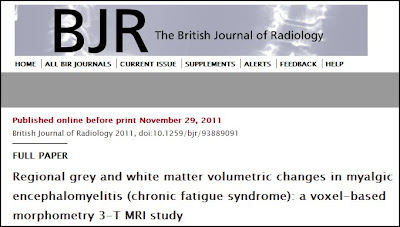November 29, 2011 British Journal of Radiology 2011:
Published online before print November 29, 2011
British Journal of Radiology 2011, doi:10.1259/bjr/93889091
| ||||||||||||||||||||||||||||||||||||||||||||||||||||
FULL PAPER |
Regional grey and white matter volumetric changes in myalgic encephalomyelitis (chronic fatigue syndrome): a voxel-based morphometry 3-T MRI study
1 Department of Imaging, Hammersmith Hospital, London, UK 2 Department of Physical Education and Sport Sciences, University of Limerick, Republic of Ireland 3 University of Hertfordshire, and Care Principles, Rose Lodge, Langley, West Midlands, UK 4 The Ridge Hill Centre, Dudley, UK 5 Brooklands Hospital, Birmingham, West Midlands, UK 6 Broadmoor Hospital, Berkshire, UK 7 Three Bridges Unit, WLMHT, Middlesex, UK 8 National Hospital for Neurology and Neurosurgery, Queen Square, London, UK
Objective: It is not established whether myalgic encephalomyelitis/chronic fatigue syndrome (CFS) is associated with structural brain changes. The aim of this study was to investigate this by conducting the largest voxel-based morphometry study to date in CFS.
Methods: High-resolution structural 3-T cerebral MRI scanning was carried out in 26 CFS patients and 26 age- and gender-matched healthy volunteers. Voxel-wise generalised linear modelling was applied to the processed MR data using permutation-based non-parametric testing, forming clusters at t > 2.3 and testing clusters for significance at p < 0.05, corrected for multiple comparisons across space.
Results: Significant voxels (p < 0.05, corrected for multiple comparisons) depicting reduced grey matter volume in the CFS group were noted in the occipital lobes (right and left occipital poles; left lateral occipital cortex, superior division; and left supracalcrine cortex), the right angular gyrus and the posterior division of the left parahippocampal gyrus. Significant voxels (p < 0.05, corrected for multiple comparisons) depicting reduced white matter volume in the CFS group were also noted in the left occipital lobe.
Conclusion: These data support the hypothesis that significant neuroanatomical changes occur in CFS, and are consistent with the complaint of impaired memory that is common in this illness; they also suggest that subtle abnormalities in visual processing, and discrepancies between intended actions and consequent movements, may occur in CFS.


1 comment:
Interesting, given Dr Puri's long-term contributions to the ME literature. Unfortunately the abstract did not state selection criteria for ME patients which is essential if we are to know the implications and applicability of the findings.
Also see:
http://www.ncbi.nlm.nih.gov/pubmed/21672323
J Int Med Res. 2011;39(1):212-4.
Increased tenderness in the left third intercostal space in adult patients with myalgic encephalomyelitis: a controlled study.
Puri BK, Gunatilake KD, Fernando KA, Gurusinghe AI, Agour M, Treasaden IH.
Source
Imaging Department, Hammersmith Hospital, Du Cane Road, London W12 0HS, UK. basant.puri@imperial.ac.uk
Abstract
A clinical sign has not thus far been associated with myalgic encephalo myelitis (ME). The present study involved systematic clinical examination that included inspection, palpation, percussion and auscultation of the thorax of 42 ME patients and 20 age-matched healthy controls while sitting. Left lateral third intercostal space tenderness was noted in 34 (81%) of the patients and in none of the controls, a difference that was highly statistically significant. This finding may be related to changes in lymphatic function and to the descending course of the thoracic duct. Further studies, preferably blinded and combined with appropriate imaging, are required.
PMID: 21672323 [PubMed - indexed for MEDLINE]
MeSH Terms
Post a Comment